Enterprise Architecture Assessment and Roadmap for Archifarm Business
VerifiedAdded on 2020/04/29
|10
|1550
|221
Report
AI Summary
This report provides a detailed analysis of Archifarm's enterprise architecture, examining the current baseline architecture, the proposed target architecture, and the gap analysis between the two. The baseline architecture describes the existing state of Archifarm's business operations, including stakeholders, goals, and organizational structure. The target architecture outlines the desired future state, incorporating improvements such as the implementation of PLF technologies for automated disease management and consolidation of farm sites. The gap analysis identifies the differences between the baseline and target architectures, highlighting the challenges and investments required for implementation. The report also includes a roadmap illustrating the steps to achieve the target architecture, emphasizing the potential for increased profitability through reduced costs and improved efficiency. The analysis covers various aspects of the business, including business functions, processes, and organizational structure, providing a comprehensive overview of Archifarm's enterprise architecture and its potential for improvement.
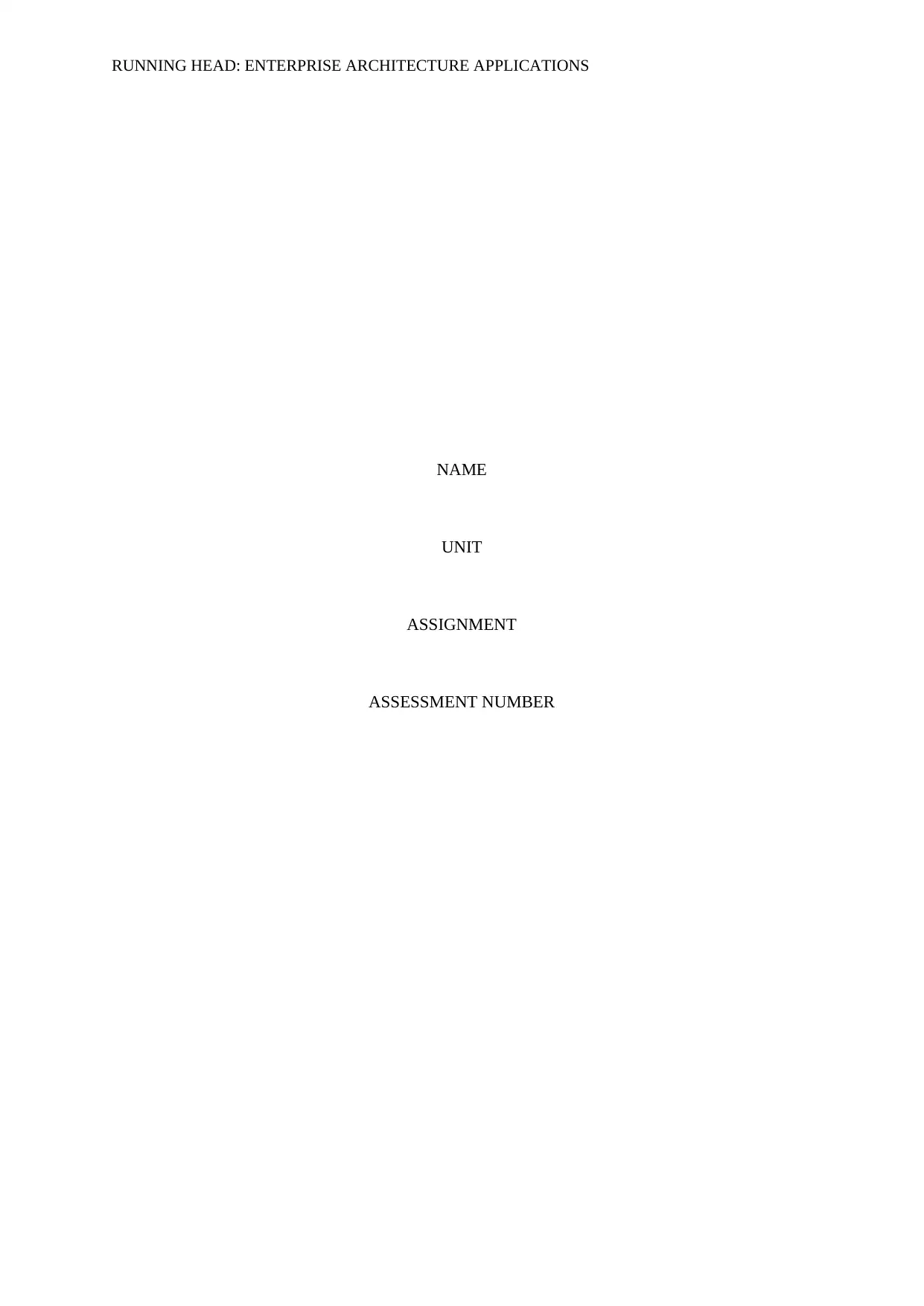
RUNNING HEAD: ENTERPRISE ARCHITECTURE APPLICATIONS
NAME
UNIT
ASSIGNMENT
ASSESSMENT NUMBER
NAME
UNIT
ASSIGNMENT
ASSESSMENT NUMBER
Paraphrase This Document
Need a fresh take? Get an instant paraphrase of this document with our AI Paraphraser
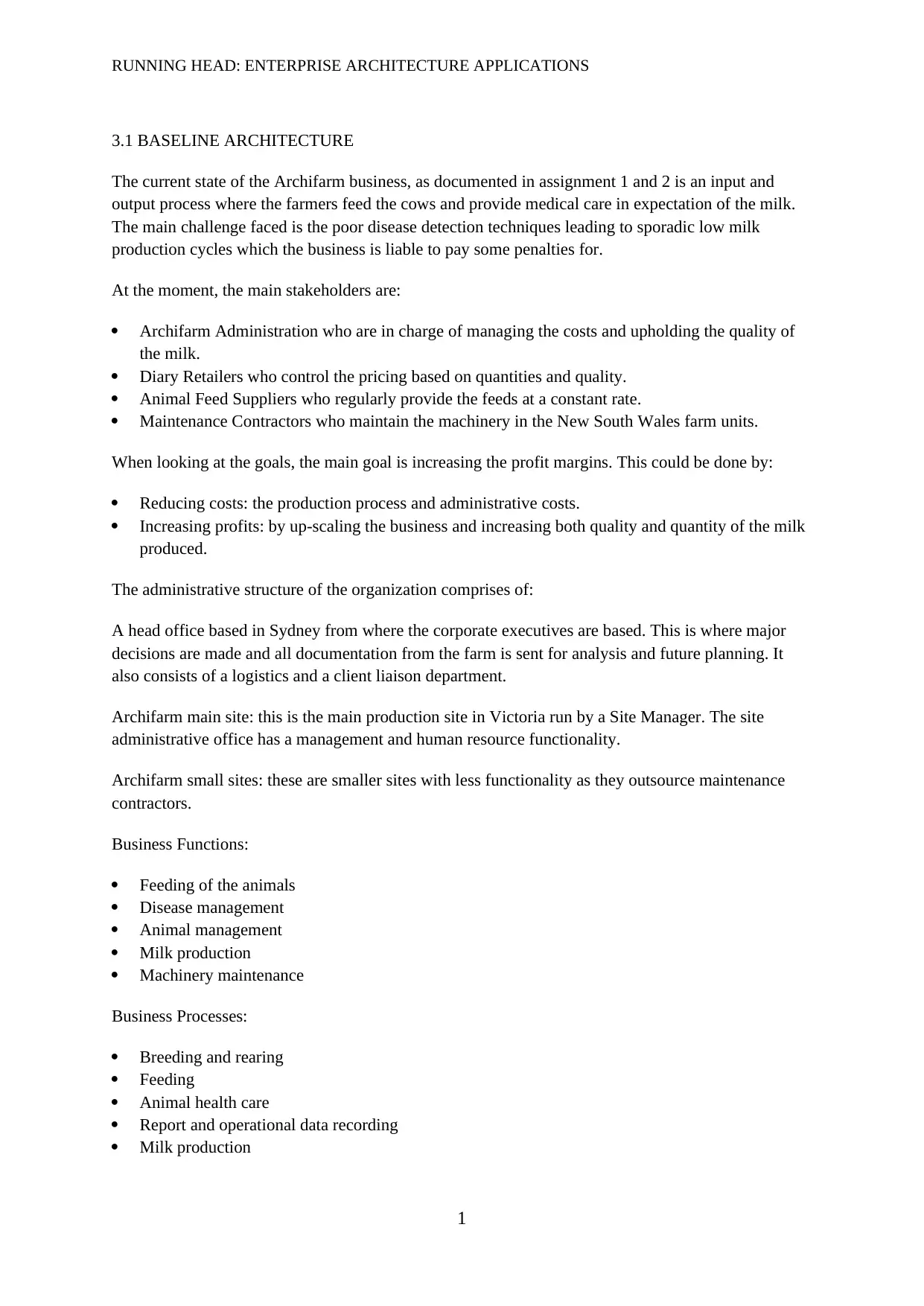
RUNNING HEAD: ENTERPRISE ARCHITECTURE APPLICATIONS
3.1 BASELINE ARCHITECTURE
The current state of the Archifarm business, as documented in assignment 1 and 2 is an input and
output process where the farmers feed the cows and provide medical care in expectation of the milk.
The main challenge faced is the poor disease detection techniques leading to sporadic low milk
production cycles which the business is liable to pay some penalties for.
At the moment, the main stakeholders are:
Archifarm Administration who are in charge of managing the costs and upholding the quality of
the milk.
Diary Retailers who control the pricing based on quantities and quality.
Animal Feed Suppliers who regularly provide the feeds at a constant rate.
Maintenance Contractors who maintain the machinery in the New South Wales farm units.
When looking at the goals, the main goal is increasing the profit margins. This could be done by:
Reducing costs: the production process and administrative costs.
Increasing profits: by up-scaling the business and increasing both quality and quantity of the milk
produced.
The administrative structure of the organization comprises of:
A head office based in Sydney from where the corporate executives are based. This is where major
decisions are made and all documentation from the farm is sent for analysis and future planning. It
also consists of a logistics and a client liaison department.
Archifarm main site: this is the main production site in Victoria run by a Site Manager. The site
administrative office has a management and human resource functionality.
Archifarm small sites: these are smaller sites with less functionality as they outsource maintenance
contractors.
Business Functions:
Feeding of the animals
Disease management
Animal management
Milk production
Machinery maintenance
Business Processes:
Breeding and rearing
Feeding
Animal health care
Report and operational data recording
Milk production
1
3.1 BASELINE ARCHITECTURE
The current state of the Archifarm business, as documented in assignment 1 and 2 is an input and
output process where the farmers feed the cows and provide medical care in expectation of the milk.
The main challenge faced is the poor disease detection techniques leading to sporadic low milk
production cycles which the business is liable to pay some penalties for.
At the moment, the main stakeholders are:
Archifarm Administration who are in charge of managing the costs and upholding the quality of
the milk.
Diary Retailers who control the pricing based on quantities and quality.
Animal Feed Suppliers who regularly provide the feeds at a constant rate.
Maintenance Contractors who maintain the machinery in the New South Wales farm units.
When looking at the goals, the main goal is increasing the profit margins. This could be done by:
Reducing costs: the production process and administrative costs.
Increasing profits: by up-scaling the business and increasing both quality and quantity of the milk
produced.
The administrative structure of the organization comprises of:
A head office based in Sydney from where the corporate executives are based. This is where major
decisions are made and all documentation from the farm is sent for analysis and future planning. It
also consists of a logistics and a client liaison department.
Archifarm main site: this is the main production site in Victoria run by a Site Manager. The site
administrative office has a management and human resource functionality.
Archifarm small sites: these are smaller sites with less functionality as they outsource maintenance
contractors.
Business Functions:
Feeding of the animals
Disease management
Animal management
Milk production
Machinery maintenance
Business Processes:
Breeding and rearing
Feeding
Animal health care
Report and operational data recording
Milk production
1
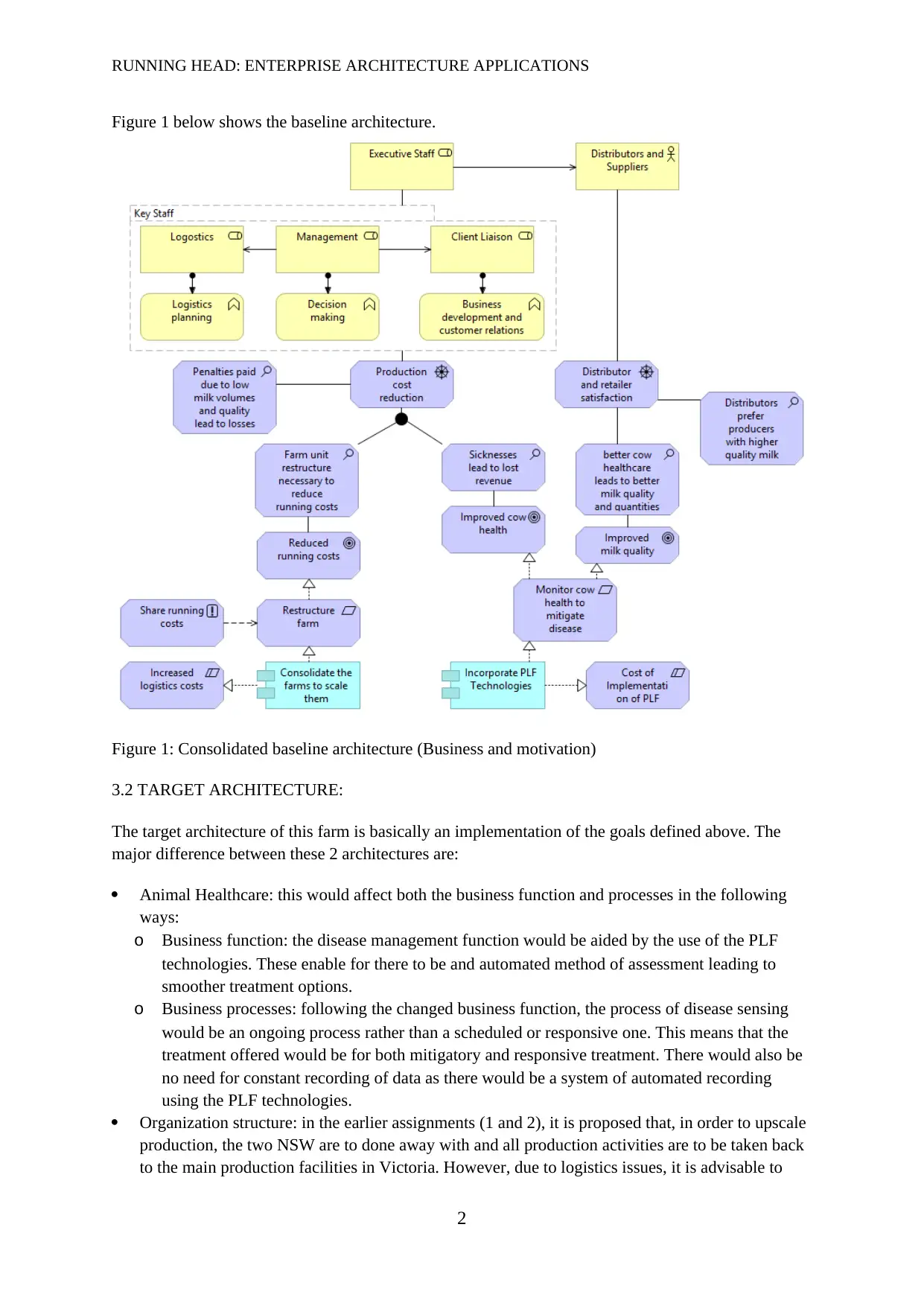
RUNNING HEAD: ENTERPRISE ARCHITECTURE APPLICATIONS
Figure 1 below shows the baseline architecture.
Figure 1: Consolidated baseline architecture (Business and motivation)
3.2 TARGET ARCHITECTURE:
The target architecture of this farm is basically an implementation of the goals defined above. The
major difference between these 2 architectures are:
Animal Healthcare: this would affect both the business function and processes in the following
ways:
o Business function: the disease management function would be aided by the use of the PLF
technologies. These enable for there to be and automated method of assessment leading to
smoother treatment options.
o Business processes: following the changed business function, the process of disease sensing
would be an ongoing process rather than a scheduled or responsive one. This means that the
treatment offered would be for both mitigatory and responsive treatment. There would also be
no need for constant recording of data as there would be a system of automated recording
using the PLF technologies.
Organization structure: in the earlier assignments (1 and 2), it is proposed that, in order to upscale
production, the two NSW are to done away with and all production activities are to be taken back
to the main production facilities in Victoria. However, due to logistics issues, it is advisable to
2
Figure 1 below shows the baseline architecture.
Figure 1: Consolidated baseline architecture (Business and motivation)
3.2 TARGET ARCHITECTURE:
The target architecture of this farm is basically an implementation of the goals defined above. The
major difference between these 2 architectures are:
Animal Healthcare: this would affect both the business function and processes in the following
ways:
o Business function: the disease management function would be aided by the use of the PLF
technologies. These enable for there to be and automated method of assessment leading to
smoother treatment options.
o Business processes: following the changed business function, the process of disease sensing
would be an ongoing process rather than a scheduled or responsive one. This means that the
treatment offered would be for both mitigatory and responsive treatment. There would also be
no need for constant recording of data as there would be a system of automated recording
using the PLF technologies.
Organization structure: in the earlier assignments (1 and 2), it is proposed that, in order to upscale
production, the two NSW are to done away with and all production activities are to be taken back
to the main production facilities in Victoria. However, due to logistics issues, it is advisable to
2
⊘ This is a preview!⊘
Do you want full access?
Subscribe today to unlock all pages.

Trusted by 1+ million students worldwide
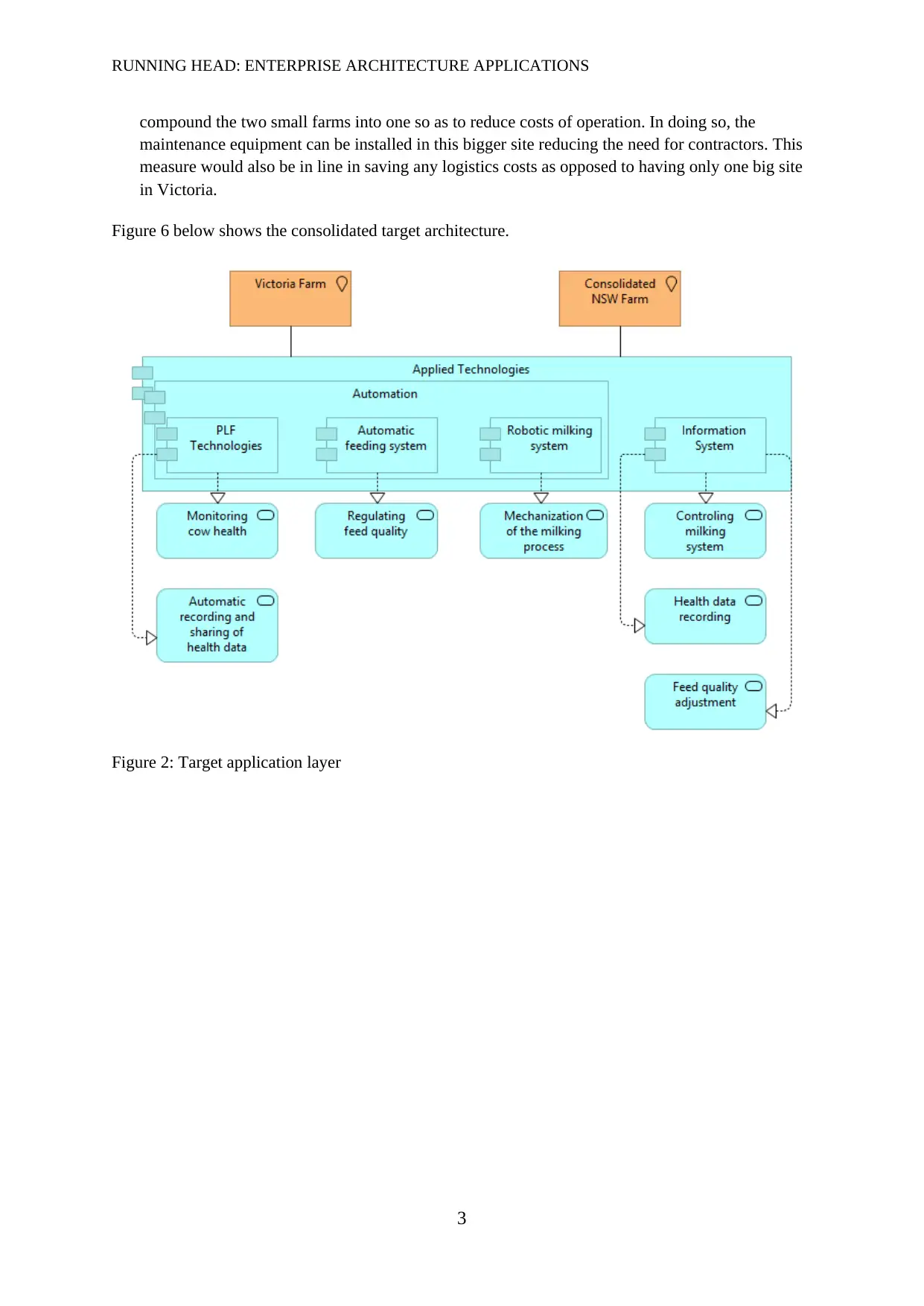
RUNNING HEAD: ENTERPRISE ARCHITECTURE APPLICATIONS
compound the two small farms into one so as to reduce costs of operation. In doing so, the
maintenance equipment can be installed in this bigger site reducing the need for contractors. This
measure would also be in line in saving any logistics costs as opposed to having only one big site
in Victoria.
Figure 6 below shows the consolidated target architecture.
Figure 2: Target application layer
3
compound the two small farms into one so as to reduce costs of operation. In doing so, the
maintenance equipment can be installed in this bigger site reducing the need for contractors. This
measure would also be in line in saving any logistics costs as opposed to having only one big site
in Victoria.
Figure 6 below shows the consolidated target architecture.
Figure 2: Target application layer
3
Paraphrase This Document
Need a fresh take? Get an instant paraphrase of this document with our AI Paraphraser
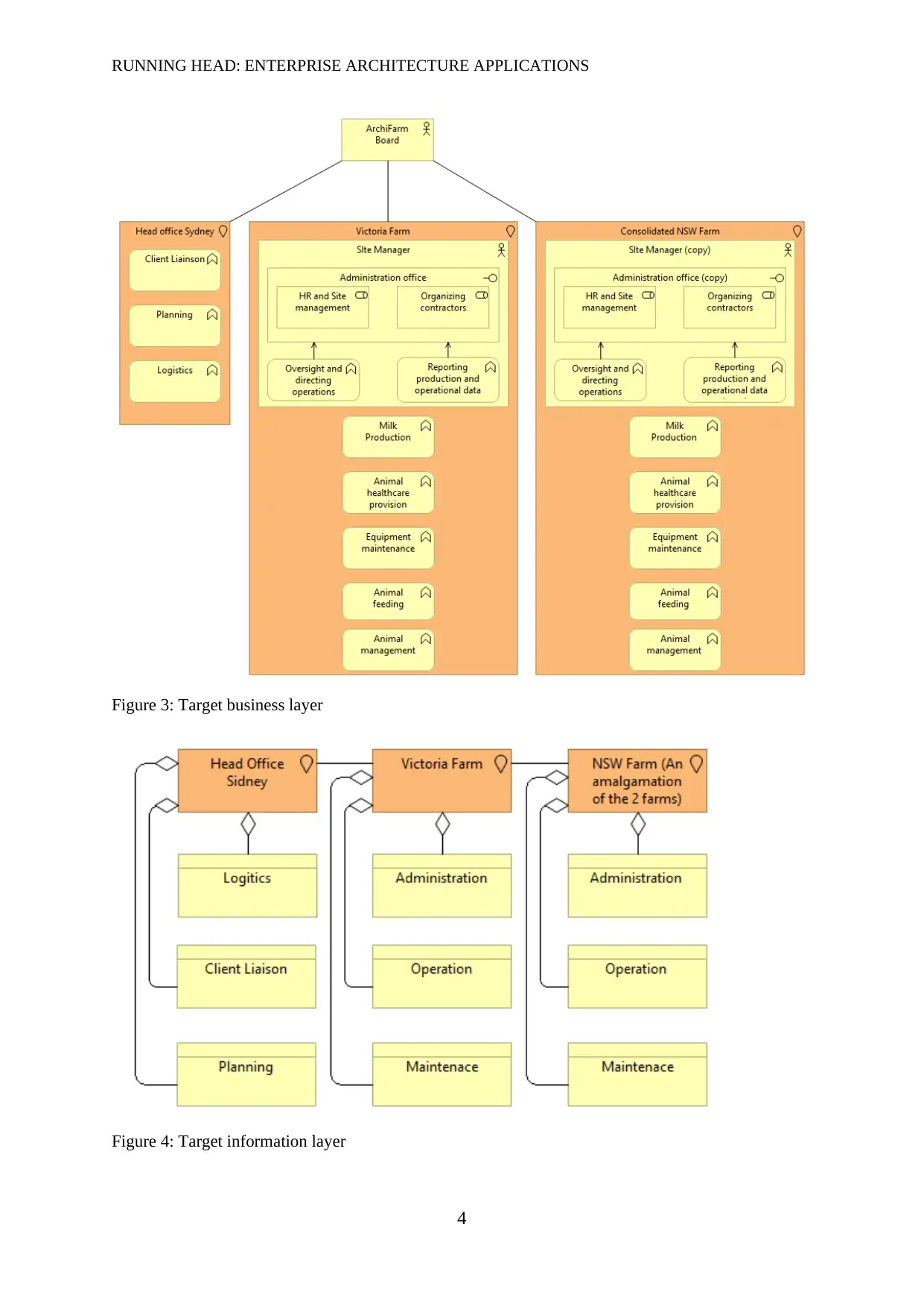
RUNNING HEAD: ENTERPRISE ARCHITECTURE APPLICATIONS
Figure 3: Target business layer
Figure 4: Target information layer
4
Figure 3: Target business layer
Figure 4: Target information layer
4
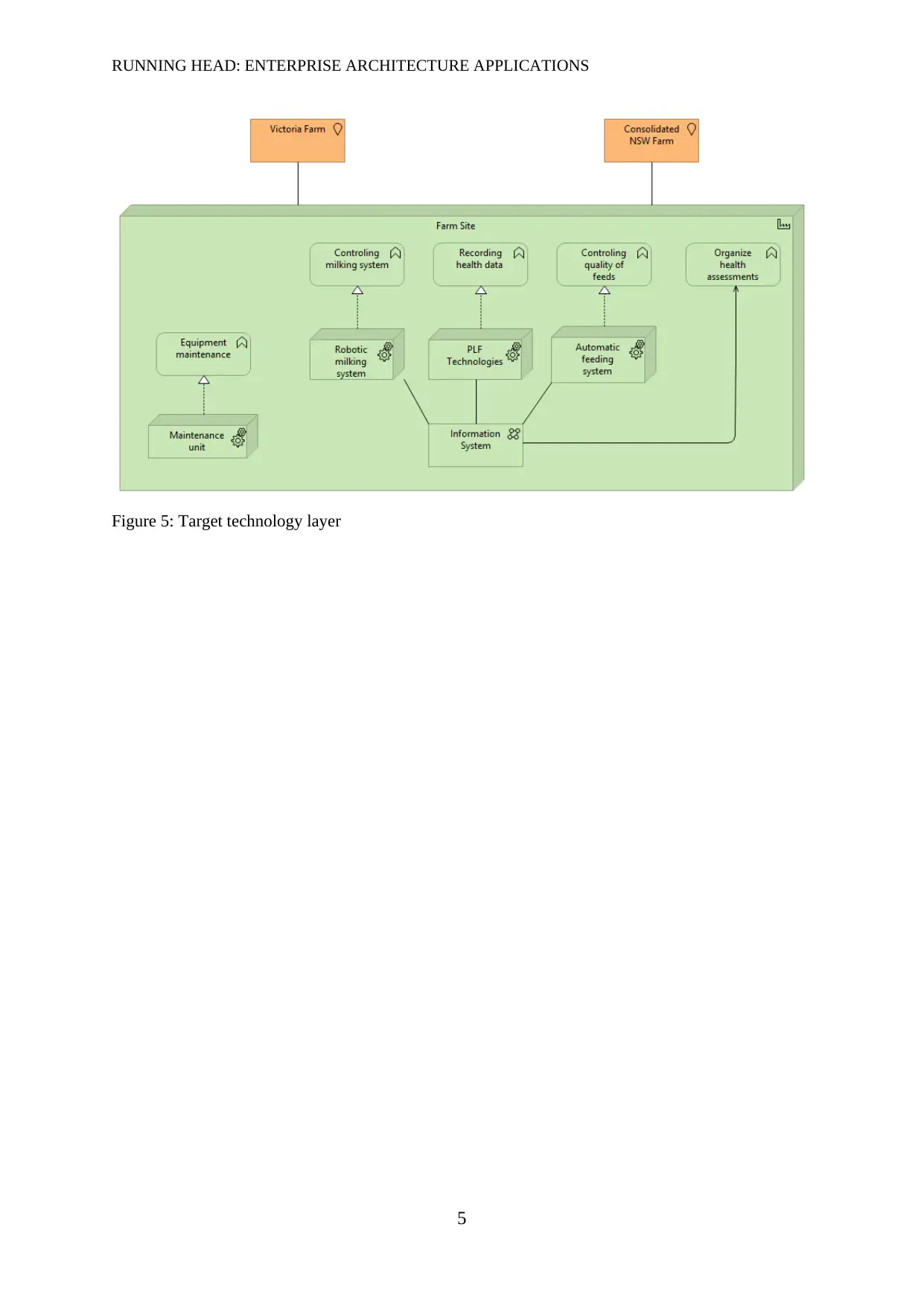
RUNNING HEAD: ENTERPRISE ARCHITECTURE APPLICATIONS
Figure 5: Target technology layer
5
Figure 5: Target technology layer
5
⊘ This is a preview!⊘
Do you want full access?
Subscribe today to unlock all pages.

Trusted by 1+ million students worldwide
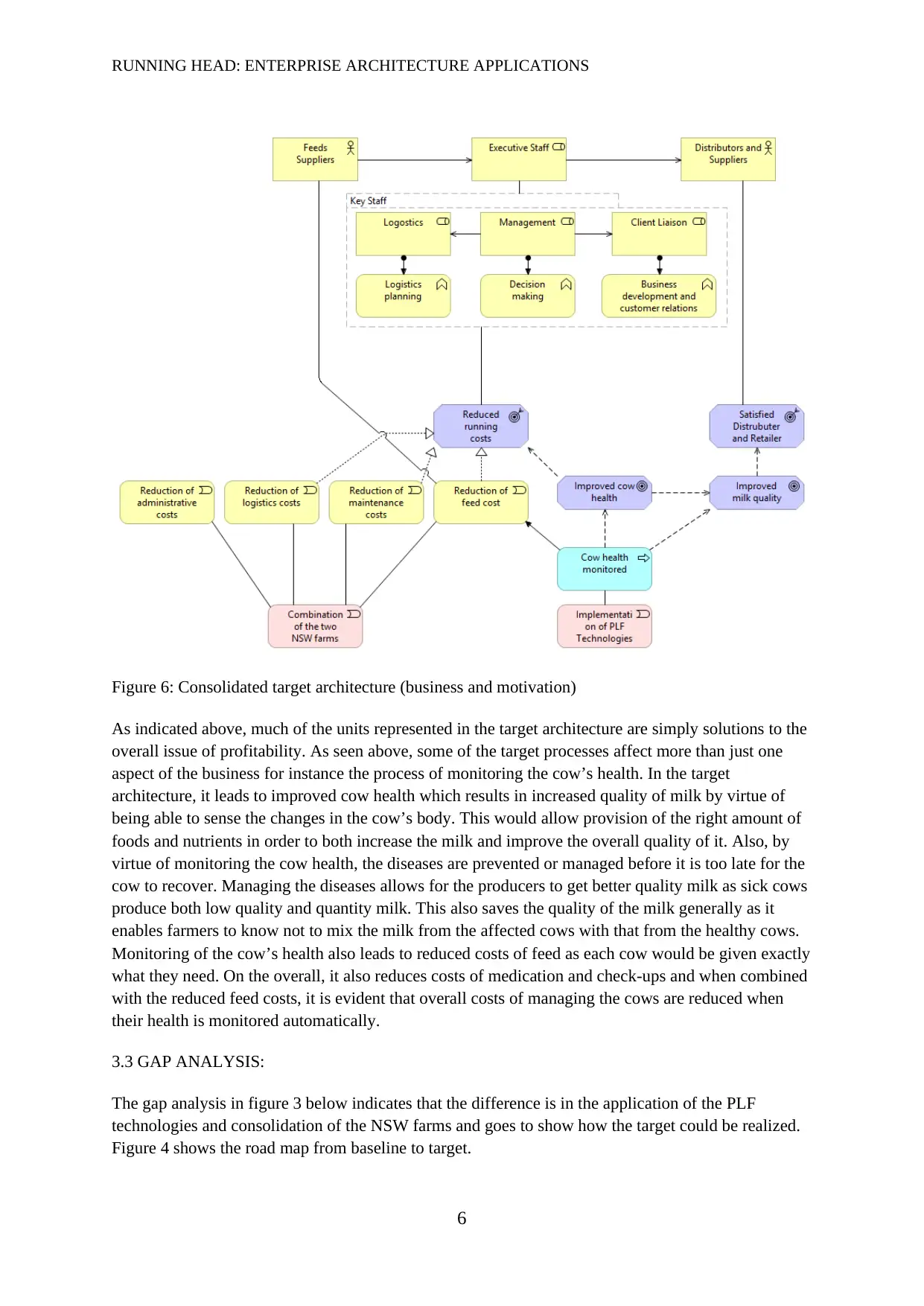
RUNNING HEAD: ENTERPRISE ARCHITECTURE APPLICATIONS
Figure 6: Consolidated target architecture (business and motivation)
As indicated above, much of the units represented in the target architecture are simply solutions to the
overall issue of profitability. As seen above, some of the target processes affect more than just one
aspect of the business for instance the process of monitoring the cow’s health. In the target
architecture, it leads to improved cow health which results in increased quality of milk by virtue of
being able to sense the changes in the cow’s body. This would allow provision of the right amount of
foods and nutrients in order to both increase the milk and improve the overall quality of it. Also, by
virtue of monitoring the cow health, the diseases are prevented or managed before it is too late for the
cow to recover. Managing the diseases allows for the producers to get better quality milk as sick cows
produce both low quality and quantity milk. This also saves the quality of the milk generally as it
enables farmers to know not to mix the milk from the affected cows with that from the healthy cows.
Monitoring of the cow’s health also leads to reduced costs of feed as each cow would be given exactly
what they need. On the overall, it also reduces costs of medication and check-ups and when combined
with the reduced feed costs, it is evident that overall costs of managing the cows are reduced when
their health is monitored automatically.
3.3 GAP ANALYSIS:
The gap analysis in figure 3 below indicates that the difference is in the application of the PLF
technologies and consolidation of the NSW farms and goes to show how the target could be realized.
Figure 4 shows the road map from baseline to target.
6
Figure 6: Consolidated target architecture (business and motivation)
As indicated above, much of the units represented in the target architecture are simply solutions to the
overall issue of profitability. As seen above, some of the target processes affect more than just one
aspect of the business for instance the process of monitoring the cow’s health. In the target
architecture, it leads to improved cow health which results in increased quality of milk by virtue of
being able to sense the changes in the cow’s body. This would allow provision of the right amount of
foods and nutrients in order to both increase the milk and improve the overall quality of it. Also, by
virtue of monitoring the cow health, the diseases are prevented or managed before it is too late for the
cow to recover. Managing the diseases allows for the producers to get better quality milk as sick cows
produce both low quality and quantity milk. This also saves the quality of the milk generally as it
enables farmers to know not to mix the milk from the affected cows with that from the healthy cows.
Monitoring of the cow’s health also leads to reduced costs of feed as each cow would be given exactly
what they need. On the overall, it also reduces costs of medication and check-ups and when combined
with the reduced feed costs, it is evident that overall costs of managing the cows are reduced when
their health is monitored automatically.
3.3 GAP ANALYSIS:
The gap analysis in figure 3 below indicates that the difference is in the application of the PLF
technologies and consolidation of the NSW farms and goes to show how the target could be realized.
Figure 4 shows the road map from baseline to target.
6
Paraphrase This Document
Need a fresh take? Get an instant paraphrase of this document with our AI Paraphraser
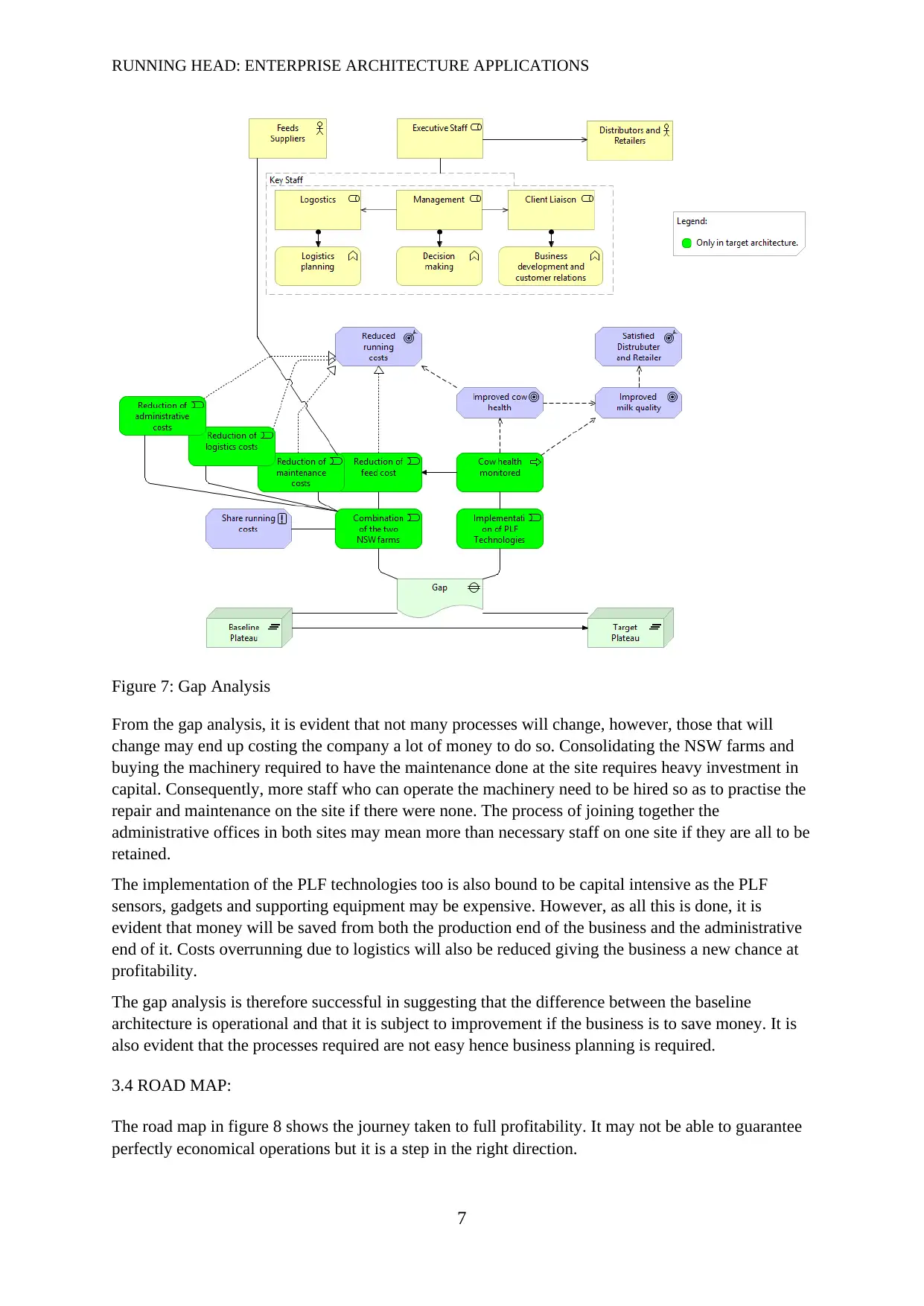
RUNNING HEAD: ENTERPRISE ARCHITECTURE APPLICATIONS
Figure 7: Gap Analysis
From the gap analysis, it is evident that not many processes will change, however, those that will
change may end up costing the company a lot of money to do so. Consolidating the NSW farms and
buying the machinery required to have the maintenance done at the site requires heavy investment in
capital. Consequently, more staff who can operate the machinery need to be hired so as to practise the
repair and maintenance on the site if there were none. The process of joining together the
administrative offices in both sites may mean more than necessary staff on one site if they are all to be
retained.
The implementation of the PLF technologies too is also bound to be capital intensive as the PLF
sensors, gadgets and supporting equipment may be expensive. However, as all this is done, it is
evident that money will be saved from both the production end of the business and the administrative
end of it. Costs overrunning due to logistics will also be reduced giving the business a new chance at
profitability.
The gap analysis is therefore successful in suggesting that the difference between the baseline
architecture is operational and that it is subject to improvement if the business is to save money. It is
also evident that the processes required are not easy hence business planning is required.
3.4 ROAD MAP:
The road map in figure 8 shows the journey taken to full profitability. It may not be able to guarantee
perfectly economical operations but it is a step in the right direction.
7
Figure 7: Gap Analysis
From the gap analysis, it is evident that not many processes will change, however, those that will
change may end up costing the company a lot of money to do so. Consolidating the NSW farms and
buying the machinery required to have the maintenance done at the site requires heavy investment in
capital. Consequently, more staff who can operate the machinery need to be hired so as to practise the
repair and maintenance on the site if there were none. The process of joining together the
administrative offices in both sites may mean more than necessary staff on one site if they are all to be
retained.
The implementation of the PLF technologies too is also bound to be capital intensive as the PLF
sensors, gadgets and supporting equipment may be expensive. However, as all this is done, it is
evident that money will be saved from both the production end of the business and the administrative
end of it. Costs overrunning due to logistics will also be reduced giving the business a new chance at
profitability.
The gap analysis is therefore successful in suggesting that the difference between the baseline
architecture is operational and that it is subject to improvement if the business is to save money. It is
also evident that the processes required are not easy hence business planning is required.
3.4 ROAD MAP:
The road map in figure 8 shows the journey taken to full profitability. It may not be able to guarantee
perfectly economical operations but it is a step in the right direction.
7
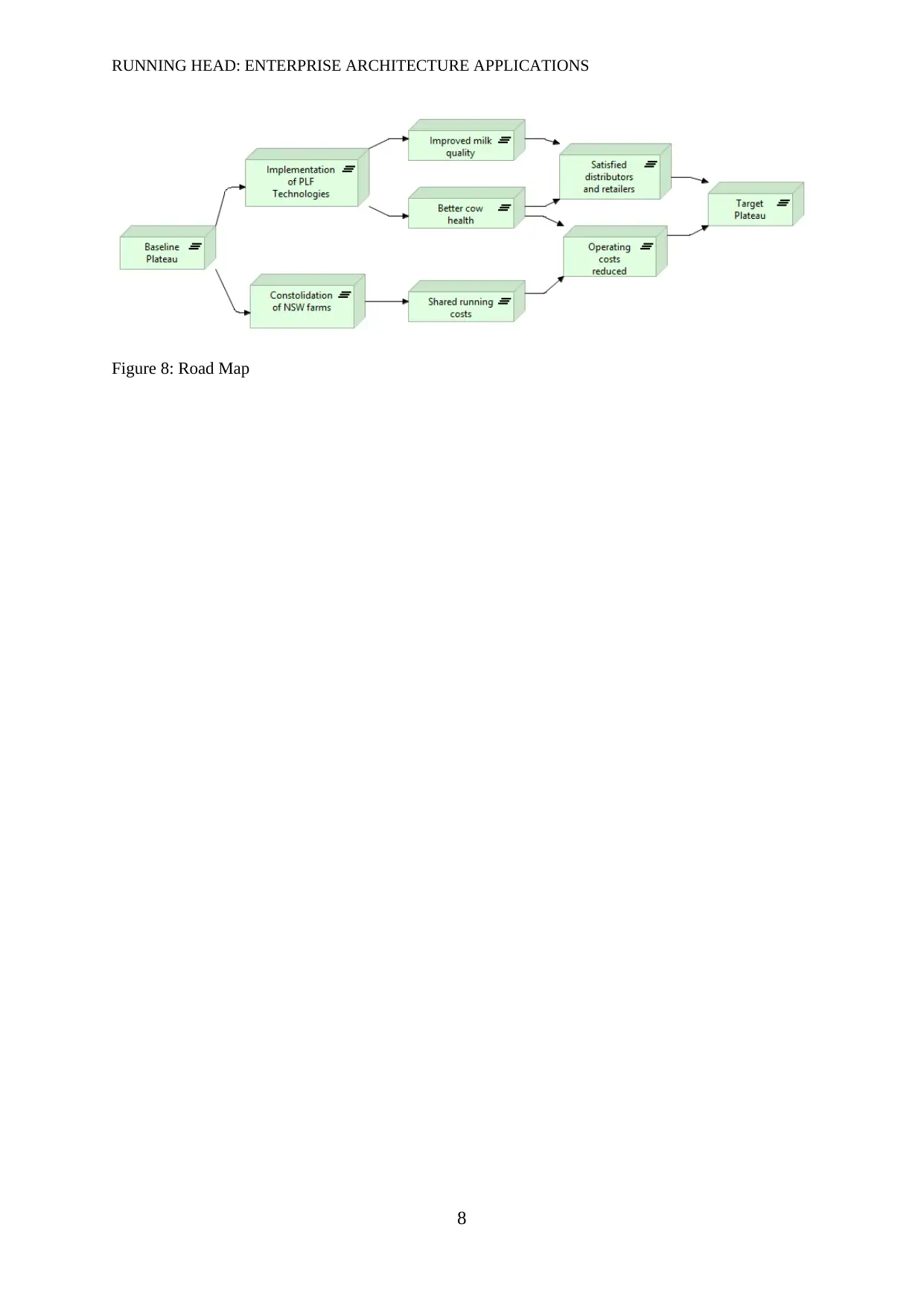
RUNNING HEAD: ENTERPRISE ARCHITECTURE APPLICATIONS
Figure 8: Road Map
8
Figure 8: Road Map
8
⊘ This is a preview!⊘
Do you want full access?
Subscribe today to unlock all pages.

Trusted by 1+ million students worldwide
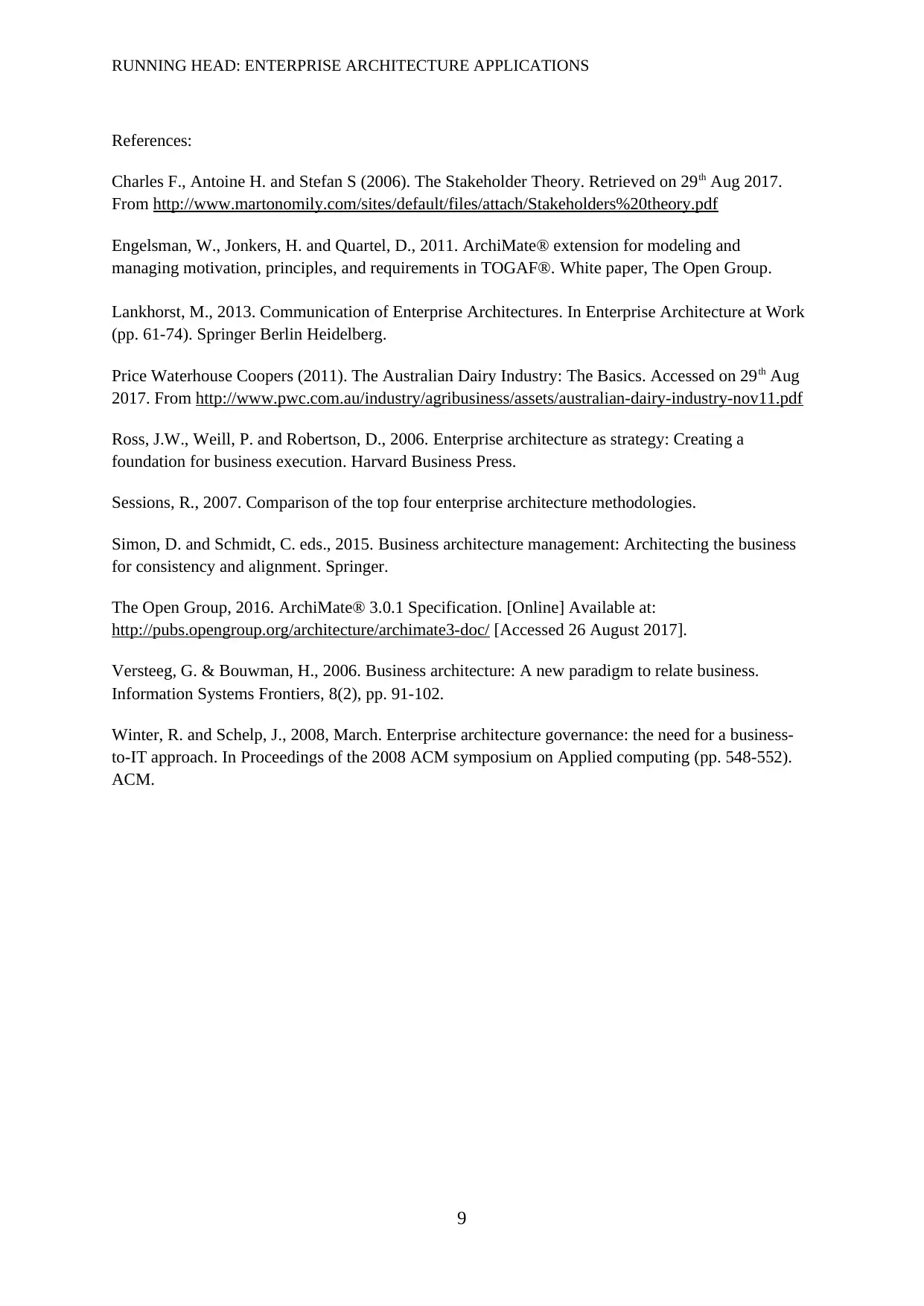
RUNNING HEAD: ENTERPRISE ARCHITECTURE APPLICATIONS
References:
Charles F., Antoine H. and Stefan S (2006). The Stakeholder Theory. Retrieved on 29th Aug 2017.
From http://www.martonomily.com/sites/default/files/attach/Stakeholders%20theory.pdf
Engelsman, W., Jonkers, H. and Quartel, D., 2011. ArchiMate® extension for modeling and
managing motivation, principles, and requirements in TOGAF®. White paper, The Open Group.
Lankhorst, M., 2013. Communication of Enterprise Architectures. In Enterprise Architecture at Work
(pp. 61-74). Springer Berlin Heidelberg.
Price Waterhouse Coopers (2011). The Australian Dairy Industry: The Basics. Accessed on 29th Aug
2017. From http://www.pwc.com.au/industry/agribusiness/assets/australian-dairy-industry-nov11.pdf
Ross, J.W., Weill, P. and Robertson, D., 2006. Enterprise architecture as strategy: Creating a
foundation for business execution. Harvard Business Press.
Sessions, R., 2007. Comparison of the top four enterprise architecture methodologies.
Simon, D. and Schmidt, C. eds., 2015. Business architecture management: Architecting the business
for consistency and alignment. Springer.
The Open Group, 2016. ArchiMate® 3.0.1 Specification. [Online] Available at:
http://pubs.opengroup.org/architecture/archimate3-doc/ [Accessed 26 August 2017].
Versteeg, G. & Bouwman, H., 2006. Business architecture: A new paradigm to relate business.
Information Systems Frontiers, 8(2), pp. 91-102.
Winter, R. and Schelp, J., 2008, March. Enterprise architecture governance: the need for a business-
to-IT approach. In Proceedings of the 2008 ACM symposium on Applied computing (pp. 548-552).
ACM.
9
References:
Charles F., Antoine H. and Stefan S (2006). The Stakeholder Theory. Retrieved on 29th Aug 2017.
From http://www.martonomily.com/sites/default/files/attach/Stakeholders%20theory.pdf
Engelsman, W., Jonkers, H. and Quartel, D., 2011. ArchiMate® extension for modeling and
managing motivation, principles, and requirements in TOGAF®. White paper, The Open Group.
Lankhorst, M., 2013. Communication of Enterprise Architectures. In Enterprise Architecture at Work
(pp. 61-74). Springer Berlin Heidelberg.
Price Waterhouse Coopers (2011). The Australian Dairy Industry: The Basics. Accessed on 29th Aug
2017. From http://www.pwc.com.au/industry/agribusiness/assets/australian-dairy-industry-nov11.pdf
Ross, J.W., Weill, P. and Robertson, D., 2006. Enterprise architecture as strategy: Creating a
foundation for business execution. Harvard Business Press.
Sessions, R., 2007. Comparison of the top four enterprise architecture methodologies.
Simon, D. and Schmidt, C. eds., 2015. Business architecture management: Architecting the business
for consistency and alignment. Springer.
The Open Group, 2016. ArchiMate® 3.0.1 Specification. [Online] Available at:
http://pubs.opengroup.org/architecture/archimate3-doc/ [Accessed 26 August 2017].
Versteeg, G. & Bouwman, H., 2006. Business architecture: A new paradigm to relate business.
Information Systems Frontiers, 8(2), pp. 91-102.
Winter, R. and Schelp, J., 2008, March. Enterprise architecture governance: the need for a business-
to-IT approach. In Proceedings of the 2008 ACM symposium on Applied computing (pp. 548-552).
ACM.
9
1 out of 10
Related Documents
Your All-in-One AI-Powered Toolkit for Academic Success.
+13062052269
info@desklib.com
Available 24*7 on WhatsApp / Email
![[object Object]](/_next/static/media/star-bottom.7253800d.svg)
Unlock your academic potential
Copyright © 2020–2025 A2Z Services. All Rights Reserved. Developed and managed by ZUCOL.





